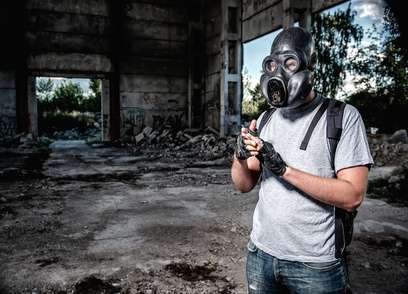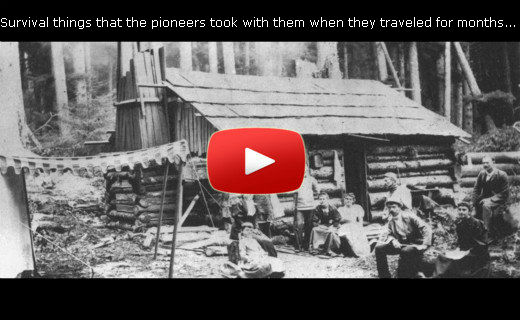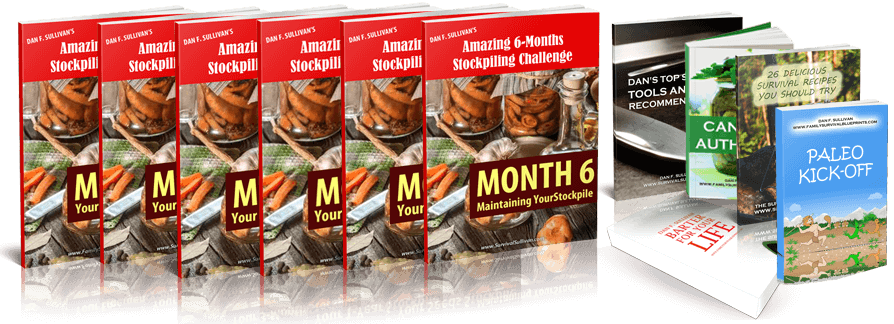Should you stockpile? Here is a complete guide to stockpiling for disaster. What you need. What you don’t need. What you should absolutely have.Discover the secrets to stockpiling …
Whether you’re bugging in or bugging out, you’ll still have to hunker down for months or maybe even a year at your bug out location. Besides security and communications, having food and water is one of the things to prepare for in advance.
How will you feed your family? How will you keep your family safe and out of harm’s way?
Now, there are two aspects to taking care of food and water. The first one is that you have to make sure you have renewable sources. A survival garden, farm animals, plenty of land, hunting and fishing are things to consider. As far as water is concerned, a river, a well and the setup to harvest rainwater will ensure you and your family can quench your thirst completely off-grid.
But if you truly want to be prepared, you cannot rely on the above. You don’t know if you’ll be able to go outside to hunt and fish. You don’t know if the rainwater or the well water you collect is safe to drink.
You need a stockpile. The bigger the better, but that doesn’t mean you have to spend thousands over the next few weeks. This takes a little bit of planning and preparing. Before we begin, let me give you an overview of what you have to do to get to a one-year stockpile without breaking the bank:
• figure out your unique situation
• figure out what to stockpile
• figure out where to store everything
• and taking it one step at a time by stockpiling in layers
Step #1: Your Unique Situation
If you’ve been a prepper for at least a couple of months, surely you’ve read at least one article about “assessing your unique situation.” To me, some of these articles are downright confusing, because most do not go into that much detail.
For stockpiling purposes, assessing your situation implies:
• knowing the number of people, pets and farm animals you’re stockpiling for
• keeping in mind the special needs of each (some may have diabetes, some may be allergic to certain foods and substances)
• knowing how much space you have at your disposal
• knowing whether or not you’ll bug in or out (because having a BOL implies you split your stockpile between the two locations, to cover both scenarios)
• figuring out which foods to stockpile and in what amounts
• setting a budget to grow your stockpile in a smart way, without breaking the bank
• figuring out the containers you’ll put your food and water in
• figuring out which comfort foods to stockpile on top of your basic stockpile
• fighting the food storage enemies (light, moisture, pests etc.)
• …and protecting your stockpile from looters
Step #2: Figuring Out What to Stockpile Ok, first thing’s first. Before you figure out how to spend your money, I have to tell you something. It’s not just food and water you have to stockpile, but other things as well:
• medicine (make no mistake about it, you will get sick post-collapse)
• clothes
• survival gear (knives, water filters, paracord etc.)
• gardening tools (where will you get new ones post-collapse?)
• cooking and eating utensils
• containers for your food and water
• plus other various items that might be impossible to acquire after the big one hits
• Let’s start with water, because it’s more important than food. Depending on how much space you have, you could store your water in…
• small, plastic bottles (if you don’t have a few inside your home or in your car for emergencies, I highly recommend you take care of this TODAY)
• 5-gallon water carriers (they need to be BPA free)
• water bricks (3 to 5 gallon containers that look like bricks and are easy to stack on top of each-other
• 55-gallon barrels (plus a water pump, to make it easier to get the water out)
• 100-gallon waterBOB (this is something you put in your bath tub the moment you hear the water is about to run out)
• There’s more to water storage than keeping the liquid of life in jugs. You also have to consider:
•where you will store everything (you can’t keep it in a hot attic, you need a cool, dark place)
• using a drinking water hose to fill your barrels
• getting some wooden pallets to place your eater barrels on
• water purification tablets (can have a shelf life of up to 4 years) or bleach (good for 3 to 6 months)
• a water filtration system as well as some personal water filters (few people know that the Sawyer Mini is better than the LifeStraw because it can purify up to 100,000 gallons of water, over 100 times more than the other)
• rotating your water stockpile (even better, you can make it a habit to always consume water from your stash and work continuously to replenish it)
• Now that we discussed water in brief (more to come at the end of this article), let’s talk about medicine. Though I am not a doctor, I can give you a few tips. First off, consider stockpiling meds and medical equipment in strategic places such as:
• your bug out bag
• your get home bag
• your car
• your home
• your bug out location
• and even your EDC kit
• But, more importantly, do NOT fall into the trap of keeping them in your bathroom. Moisture considerably decreases shelf life.
The good news is that when you buy a box of meds or bandages, it’s easy to split them across all of these places. Same thing for over the counter medications such as Ibuprofen and aspirin. In addition, you may also want to consider aloe vera gel to treat burns, antibiotic cream, alcohol pads, soap, N95 masks, Tylenol and so on.
Once your medicine stockpile is getting bigger, you’ll want to diversify even more by getting iodine tablets (useful in case of nuclear explosions and nuclear meltdowns), bandage scissors, even more types of bandages and Band-Aids, dental kits, birthing kits and on and on.
Ready to tackle food? I won’t be able to talk about every aspect here but I can at least touch on the subject. At first, you’ll need a small stockpile to cover small scale emergencies such as prolonged power outages, heavy snow and so on. Once people are bombarded with several disasters on the news, everyone will flock to the supermarket.
Multiple terrorist attacks will also send people running to the supermarkets — and key items will disappear fast.
Once you’ve got yourself covered for emergencies, consider expanding your small stockpile with the food items I’m about to share. Once that grows, consider splitting it between your home and your bug out location. If you’ve got more than one BOL, you’ll have to keep food everywhere because you don’t know where the next disaster will force you to flee.
Some of the foods to consider storing: rice, beans, pasta, canned fruits and veggies, canned fish, wheat berries, honey, peanut butter, powdered milk and so. There are a lot more that have great shelf life than you think.
Now, besides the actual foods, you should also expect to spend some money on a few other things to help you store, prepare and consume them, namely:
• containers and preservatives (Mylar bags, oxygen absorbers, food-grade plastic buckets, metal buckets to protect the plastic buckets from rodents etc.)
• utensils to process some of these foods (such as grain grinders for your wheat berries)
• food preparation utensils (pots, pans, cast iron skillets for open fire cooking), knives of various sizes, corkscrews, fish slices, funnels, a garlic press, graters and on and on and on
• disposable eating utensils (plastic forks, plastic knives etc.)
Ok, we talked about food, water and medicine, but what else should you store for a catastrophic emergency? Before I give you the list, promise me you won’t rush to buy them from Amazon, ok? Many of these are probably sitting in your attic as we speak…
• shoes and clothes (recondition them to avoid spending money on new ones)
• tarps (will be useful for a number of things, from butchering an animal to providing shade)
• Ziploc bags (you cannot have enough of)
• hygiene products (floss, toothbrushes, toothpaste etc.)
• board games (for entertainment purposes)
• condoms (would be wise to remind people how unwise a pregnancy is during a time of extended disaster; wisest move could be total abstinence from sex – but this is the real world; with that said, Biblical teachings against pre-marital sex obviously could reduce chances of pregnancy within a small community of people; in the end, condoms are for those who simply can’t go without sex; enough said)
• spare batteries for your flashlights and other electronics
• seeds
• …and many more. The list is bigger but you don’t have to get them all at once.
The good news is that most of these items (except seeds) don’t need any special conditions. You can keep them in your attic, you can keep them in your bathroom (there should be plenty of space beneath the bath-tub — you’ll need tools to create a compartment there — and homemade bed frames can be hammered together offering a ton of storage space in every room)… and in any other place where nosy neighbors and friends can’t spot them. From this point of view, the attic is the best place to store them, because no one ever goes up there. Let’s talk about this for a moment.

Step #3: Storing Your Stockpile
There are numerous places to keep it, some of them are downright crazy. Consider:
•the attic (for non-perishable items) but also keep in mind tornadoes and hurricanes which could wipe off your entire roof and, with it, your stockpile
• the basement (the best place to store food, water and even meds) but make sure it’s well ventilated and pest-free
• the garage
• and various places around the house, such as in or above kitchen cabinets, inside coffee tables, in your bathroom (do NOT store meds there because moisture will greatly reduce shelf life), inside furniture, in boxes, in your car’s trunk, in various containers inside your back yard, buried in your back yard, inside your tool shed, barn and, of course, hidden away at your bug out location
What if you live in a tiny apartment, can you still do it? Sure, but, in this case, you will need a bug out location as well as a car with a bigger trunk, to fit more emergency items. No, you can’t fit a one year stockpile in there but every extra gallon of water could make a difference.
Speaking of trunks, know that they can get pretty hot during the summer. Even if temperatures won’t be that high, temperature variations are also a factor in decreasing food shelf life. This is why you should rotate the foods, water and meds that you keep in your car more often, say, every 6 months.
A small trick you can use to ensure they last longer is to get a few wide-mouth thermoses and keep them inside. This will minimize temperature variations a little, but don’t expect them to work wonders.
Step #4: Stockpiling in Layers I briefly touched on this aspect earlier in the article but it’s something definitely worth expanding on. Before you think about a one year stockpile, you first need to worry about your immediate needs. What if there’s a storm or other catastrophic weather event in the coming weeks, will you be covered for a few weeks from all angles?
The layers are:
• a 3-day stockpile
• a 3-week stockpile
• a 3-month stockpile
• and, of course, a one year stockpile Like I said, it’s easy to split your items between your home stockpile, your BOL stash, your car’s trunk and your survival bags.
Here’s the thing: no matter which disaster strikes… whether it’s an EMP, Martial Law or an economic collapse, you need food in order to survive. And plenty of it. Looking back in history at what happened after some of the biggest events humanity had to face, they all lasted YEARS before things went back to some sort of normal.When food is lacking, society breaks loose… and the next gobal war might not be fought for gold or any other riches… but for basic human resources: food, clean water and medicine.
All of this sounds great and I’m ready to start a stockpile! But do you have more info and advice? I sure do. I realized not too long ago that most preppers are looking to bug in. It makes sense because bugging out could be downright dangerous. I also realized there’s no A to Z guide for making a “bulletproof” stockpile for newbies, so I have spent a few dedicated months to perfecting a survival guide like no other. Of course, there is a small fee for it because it took a great deal of time, effort and research to put it together, but I also made a video where I tell you exactly what’s in it.
You’ll not only learn how to prepare in layers, which foods and products are best but this guide is “highly customizable” so to speak, meaning I truly tackle the stockpiling issue for your unique situation, as I mentioned in the beginning of this article.
Click this link to watch the presentation and get started building a stockpile in record time and with a record budget.








